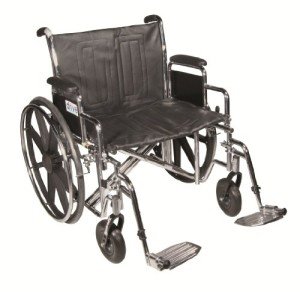Bariatric Wheelchair Seat Width
Seat Width
Having the appropriate seat width is essential to wheelchair users who invest longer periods in their chairs. Too narrow a seat will cause pressure on the hips and thighs which might result in sores or pressure points. Having too wide a seat can likewise make it tough for the user to reach the hand rims to move themselves or maneuver in little areas.
To determine the appropriate seat width a person would rest on a chair typically and have their measurement taken throughout their lap at the largest point which is usually their hips. A wheelchair measuring tape can be used to measure this, but a yard stick is chosen as it prevents people from covering the tape around their hips which would provide an inaccurate result.

The standard wheelchair seat width is 16" (narrow grownup), 18" (standard grownup), and 20" (broad grownup). For bariatric patients, a 24" seat is readily available. This heavy-duty additional wide bariatric wheelchair from Medline includes swing-away footrests, a carbon steel frame with rust- and chip-resistant chrome plating, and easy-to-clean vinyl upholstery. It has a weight capacity of 500 pounds.
Seat Depth
Generally, the seat depth of a bariatric wheelchair was included 2" to the measurement taken at the user's largest point (usually their hips). This was meant to accommodate additional layers of clothing that may be worn throughout winter. Nevertheless, this practice is ending up being less typical as wheelchair users are able to invest more time indoors and are not wearing long coats. This makes the seat depth of a chair lesser when picking a bariatric wheelchair. Nevertheless, it is still important to select an alternative that offers appropriate assistance for bigger users.
The Medline folding additional broad bariatric manual wheelchair includes a comfy 24" seat width and a heavy-duty slide tube silver vein frame. It also has an adjustable axle and tool-free raising legrests.
Seat Height
When it comes to determining the proper wheelchair seat width you need to always measure from the user's largest point which is normally their hips. You will likewise need to think about whether the user is going to be wearing a winter season coat as this might include 2" to the width needed.
When a wheelchair is in usage it need to just be run on level surfaces with the wheel locks fully engaged. This is to avoid the chair from being able to move slopes that are 10 degrees or higher. It is also essential to bear in mind that any activity that may shift the center of mass in the chair must be finished with care. This includes reaching for items that require the person to lean out of their seat or attempting to stand from it.
Whenever you have the chair in usage it is advised that you regularly examine it for damage and lube any areas that are deemed needed. For example, the casters ought to be lubed by eliminating the caster fork and utilizing a multi-purpose grease to use to the caster stem bearings. Similarly, the foot plates can be changed by loosening up the bolt and then moving them to the preferred position. This permits the feet to sit easily on the footplate and prevents any pressure points from forming. This can be extremely uneasy for the user and if left ignored, can lead to press sores.
Weight Capacity
Bariatric wheelchairs are developed to support more weight than standard wheelchairs. This makes them sturdier and much better equipped to handle falls. lightweight bariatric wheelchair are likewise normally bigger and larger, making them less maneuverable in tight areas than standard wheelchairs. They require cars with unique ramps and lifts to pack them, as well as motorists who know how to best transport them from one area to the next.
When selecting a wheelchair, consider its weight capacity as it will be the main determining aspect in whether it will accommodate your passenger's requirements. The weight capacity of the chair is often noted as a static load, implying that it suggests the amount of weight the chair can comfortably hold while stalling. Nevertheless, some producers likewise list an active load that is based on a drop test and can simulate the result of someone sitting down in the chair. This may be a more dependable measurement of the weight limit, depending upon your requirements.
If you plan to carry out activities that shift your center of gravity in the seat (such as reaching for things), make certain to have front casters pointed in a forward instructions and wheel locks engaged so the chair will not topple. Also, check that casters are oiled frequently to avoid extreme wear and abrasions. The lubrication treatment includes eliminating the fork, separating the caster from the wheel, and greasing the caster stem bearings with premium multi-purpose grease.
